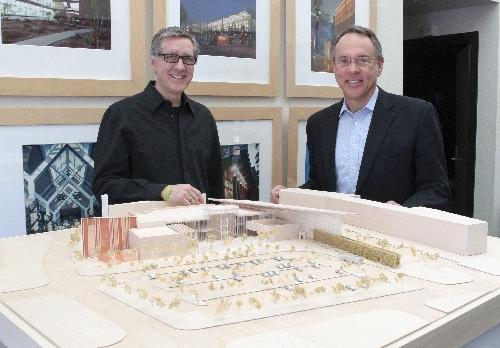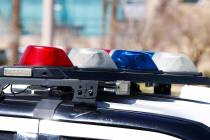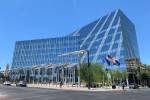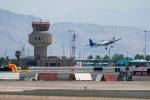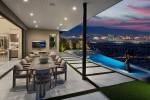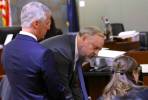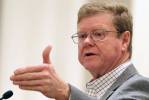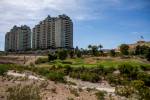Space and science center project in Henderson faces hurdles
Former Henderson Mayor Jim Gibson wants to keep students from spacing out by getting them into outer space -- and science, math and technology, too.
Gibson and a dozen other people have worked for more than three years as a board of directors for the Henderson Space & Science Center in Nevada, a nonprofit organization.
He isn't the only former mayor involved in the project. Ron Lurie, the board's treasurer, was Las Vegas' mayor from 1987 to 1991.
Former Henderson City Attorney Shauna Hughes is a director. Other directorships are filled by architects and engineers. Two others have doctorates.
All share a vision to build a space and science center that would be part museum and part university, a place where not only the mind is engaged, but also the hands and the body.
There is no other facility like the proposed center , Gibson points out.
The idea was conceived nearly 20 years ago. That was when the Southern Nevada economy was going great guns. Those guns have been silenced for several years now and the project is threatened as both the public and private sectors continue to struggle.
The plan was to seek private donations, endowments and federal grants to pay for about two-thirds of the $63 million project with the city of Henderson chipping in $21 million.
But the City Council continues to struggle with a $27 million budget shortfall projected over the next two years.
Ordinary people and businesses don't have the money to donate to projects like this as they did a few years ago.
And City Manager Mark Calhoun has suggested the council shift its funding priorities away from the center to focus on what he considers more pressing capital projects. He wants elected officials to take back the $21 million they pledged to the project in 2009.
Councilwoman Debra March last week said backers need to show they can raise about $42 million before the city hands over any cash. "They have everything they need to begin fundraising efforts," she said. She also wants the center to conduct a second feasibility study. The one it's using was commissioned in 2006, before the economy tanked.
Bottom line: The project is in trouble.
THE DREAM LIVES ON
While funding remains a daunting task in today's economy, the Space & Science Center could play a significant role in steering young people into careers now in demand. In fact, Gibson said influencing young minds is the core mission.
"We're at the point to take the design to the next level," Gibson said when the model was unveiled Feb. 10. "The thing we've needed is something we can show people; that this is what we hope to accomplish," he said of the model.
Gibson said the board was "really fortunate" to land the services of "a talented group of local architects and engineers to really focus and lead this effort." Tate Snyder Kimsey Architects built the model that Gibson, former Councilman Jack Clark and others plan to use as a fundraising tool.
Gibson and Clark were scheduled to bring the model to the Feb. 21 City Council meeting to bolster their request for $2.9 million to pay for more architectural work and to hire a design and construction director.
The former mayor asked for a postponement once it became apparent the council had no appetite to approve the request.
According to the center's own literature, the ultimate goal "is to get our community excited about science by providing access to knowledge that will change individual lives and impact our common future."
The center would do that through the creation of an interactive educational experience. Sure, there would be plenty of museum-style exhibits, but plans also call for significant interactive exhibits -- think of a wind tunnel and human confrontation with the forces of nature, or feeling the joyous wonder of orbiting the Earth.
The center also would host school field trips, outreach activities, after-hours get-togethers and other programs designed to give students, their parents and others hands-on experience.
Educators have found that playing the game is much more interesting than watching it -- and just like a good coach coaches to a player's strengths, the programs the center incorporates would focus on teaching children how to learn in their own way.
The grand opening is planned for summer 2015. Clark estimates about 350,000 people would visit each year. He said the estimate is likely closer to 400,000, but the board chose a more conservative figure.
MUCH MORE THAN A MUSEUM
If Gibson is the quarterback leading the effort to build a space center, Clark is the head cheerleader.
Clark, a retired police officer, said a constituent proposed building a "Space Camp West" shortly after he took office in 1993.
"The idea evolved more into a space and science center over the past 18 years," Clark said. "The biggest confusion is that this will be a museum in the traditional sense. It's more of an exploratorium. They don't want to hear about it, they want to do it. We want to open a door in their minds."
Clark has a response to critics who say the space and science center is folly. "When (President John F.) Kennedy announced we would land men on the moon and bring them back safely by the end of the 1960s, America had 15 minutes of experience in space."
Kennedy was speaking of Alan Shepard when he made that bold pronouncement in May 1961.
Coincidentally, the push to conquer space was in response to the United States playing catch-up with the old Soviet Union, which in April 1961 sent the first man into space.
Space and science center proponents and the city itself began their own game of catch-up in 2009, and signs that not all the players were on the same page immediately surfaced.
That summer the City Council in a controversial vote gave the project
$21 million out of its public lands fund. It was one of the last votes of the outgoing Gibson, the president of the Henderson Space & Science Center, and Clark, its executive director .
The decision was amended a couple of weeks after both men left public office -- Gibson after 12 years of service and Clark after 16 years. The funding was still available, but the city would hold onto it, collect the interest it accrued, and dole out piecemeal what the center needed.
Both Gibson and Clark were accused of having a conflict of interest for their respective votes, which rankled newly elected council members who didn't share their passion.
The city's wholesale reluctance to give the center funds that it pledged three years ago and its serious budget shortfalls make it unlikely "taxpayer money" would ever be used. Both Gibson and Clark agree that is as it should be. But they also point out that developers filled the coffers of the city's land fund, which is the account they seek to tap. Because of the bad economy, the land fund has been significantly reduced.
FILLING THE EDUCATION GAP
Planned for Galleria Road and U.S. Highway 95, the center would help anchor the proposed $1.5 billion Union Village project that will feature several hospitals, medical clinics and mixed-use housing on 160 acres.
"We've known all along we wanted a place to expose school students to space and various sciences," said Gibson, who added that they wanted a place where kids of all ages learn and feel compelled to revisit.
Students won't be the only beneficiaries if the vision is realized. Gibson said adults would also find the place interesting, but more important, teachers could learn how to teach the sciences and ultimately inspire children to enter the field.
The project comes at a time when U.S. students have fallen behind the students of other developed nations in math and science test scores -- and students in Nevada rank near the bottom among the states, according to Gibson.
There's more at stake than bragging rights. The job market seeks workers skilled in science, technology, engineering and math -- and the pickings are slim.
"We're falling way behind," Clark said. "We've kind of lost our way. Look at India. That's a nation that understands the way out of poverty is education. We're losing our edge and the government won't get it back for us. It's up to us."
"Think about the education system," Gibson said. "We don't often say real good things about the state of education. We read a lot about the failures."
DOWN ECONOMY SLOWS PROJECT
Gibson said it's difficult to say what effect the tanked economy has had on the center, beyond the obvious.
"We didn't know we would need this much money when we first set out," he said. "The economy obviously is an issue because the city is struggling and their focus, rightly, is on trying to overcome the challenges right in front of them."
Gibson said the current City Council has done an outstanding job reacting to the downturn, but the need for the space and science center didn't evaporate along with revenues.
"I know nobody anticipated such a remarkable decline," he said. "It's deeper than anyone could have imagined, but because of great work done by the city for many years, they've weathered the storm.
"This bad economy is going to end, and the need for the center existed when the tide was high and it exists while the tide is low."
That need, he said, is not the kind that goes at the top of a wish list, but at the top of a to-do list.
"It is that dreaming of a future, of doing things nobody ever told them they could do, that counts," Gibson said. "Whether it leads them to do something in space or not misses the point. The point is that we need to inspire these kids to have dreams and to have hopes.
"It's all about aspirations."
The center's board of directors now aspires to inspire potential donors to dig deep.
Contact reporter Doug McMurdo at
dmcmurdo@reviewjournal.com or 702-224-5512.
SPACE & SCIENCE CENTER
■ Vision: Create an experience to inspire the future.
■ Mission: Raise an understanding of space, science and technology with an emphasis on their application.
■ Funding: The city of Henderson provided five acres north of Galleria Drive and east of U.S. Highway 95 and $21 million from the city's Public Lands fund. The board of directors hopes to raise the remaining $42 million from private donations, grants and endowments.
■ Scope: More than 68,000 square feet of exhibit space inside a 90,000-square-foot building. Outdoor exhibit space will take up another 40,000 square feet.
THE COMPETITION
Facing unprecedented economic challenges, the Henderson City Council has several capital projects that City Manager Mark Calhoun thinks are more important to the city than is the proposed Henderson Space & Science Center.
A few of these projects are attached to grants that could be lost if the city doesn't pay its matching share. They represent between $40 million and $47 million in costs and Calhoun suggests the City Council take at least some of this money out of its land fund, which has about $33 million. The City Council voted to gift the space and science center $21 million from this account.
The projects include:
■ $13 million to $20 million to remodel and build an addition at the city's aging convention center.
■ $13.7 million to build a fleet maintenance facility.
■ $5.5 million to upgrade the Henderson Pavilion.
■ $4 million to build a training facility that would serve the Henderson and Boulder City police departments.
■ $3 million in economic development seed money that would be used to lure business.
■ $500,000 to install photovoltaic solar power cells at Heritage Park.
■ $300,000 to upgrade a weight room and gym for police and firefighters and an equal amount to improve the Fire Department Training Center.
Las Vegas Review-Journal




